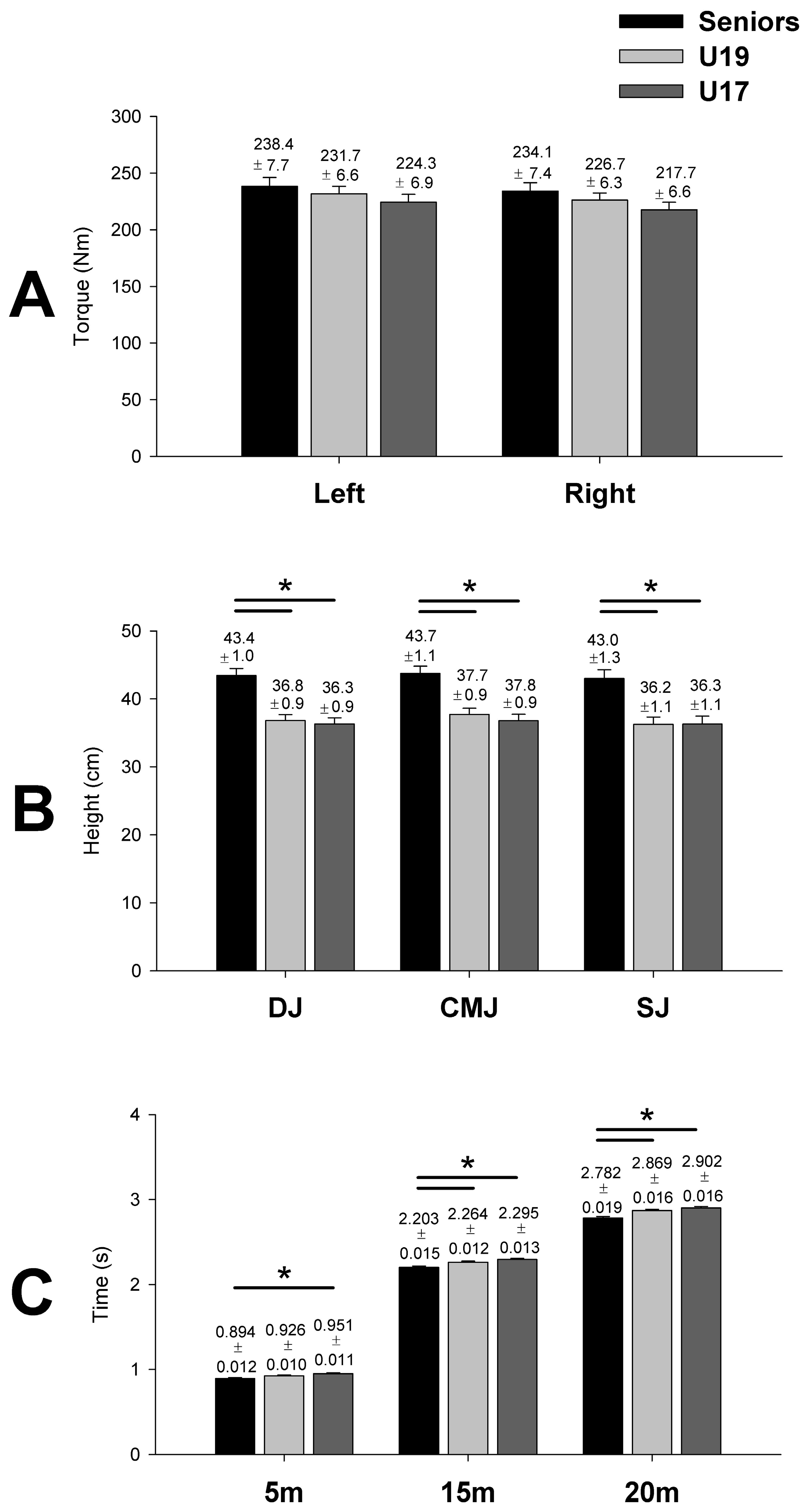Do Young Elite Football Athletes Have the Same Strength and Power Characteristics as Senior Athletes?
Abstract
:1. Introduction
2. Materials and Methods
2.1. Participants
2.2. Procedures
2.3. Measures
2.4. Statistical Analysis
3. Results
4. Discussion
5. Conclusions
Acknowledgments
Author Contributions
Conflicts of Interest
References
- Stølen, T.; Chamari, K.; Castagna, C.; Wisløff, U. Physiology of soccer: An update. Sports Med. 2005, 35, 501–536. [Google Scholar] [CrossRef] [PubMed]
- Silva, J.R.; Nassis, G.P.; Rebelo, A. Strength training in soccer with a specific focus on highly trained players. Sports Med. Open 2015, 1, 17. [Google Scholar] [CrossRef] [PubMed]
- Le Gall, F.; Carling, C.; Williams, M.; Reilly, T. Anthropometric and Fitness Characteristics of International, Professional and Amateur Male Graduate Soccer Players from an Elite Youth Academy. J. Sci. Med. Sport 2010, 13, 90–95. [Google Scholar] [CrossRef] [PubMed]
- Vescovi, J.D.; Rupf, R.; Brown, T.D.; Marques, M.C. Physical performance characteristics of high-level female soccer players 12–21 years of age. Scand. J. Med. Sci. Sports 2011, 21, 670–678. [Google Scholar] [CrossRef] [PubMed]
- Dowson, M.N.; Cronin, J.B.; Presland, J.D. Anthropometric and physiological differences between gender and age groups of New Zealand National soccer players. In Science and Football IV; Murphy, A., Reilly, T., Spinks, W., Eds.; Routledge: Abingdon, UK, 2002; pp. 63–71. ISBN 9780415241519. [Google Scholar]
- Kellis, S.; Gerodimos, V.; Kellis, E.; Manou, V. Bilateral isokinetic concentric and eccentric strength profiles of the knee extensors and flexors in young soccer players. Isokinet. Exerc. Sci. 2001, 9, 31–39. [Google Scholar]
- Nikolaidis, P.T. Age-related Differences in Countermovement Vertical Jump in Soccer Players 8–31 Years Old: The Role of Fat-free Mass. Am. J. Sports Sci. Med. 2014, 2, 60–64. [Google Scholar]
- Nikolaidis, P.T. Age-Related Differences in Force-Velocity Characteristics in Youth Soccer. Kinesiology 2012, 44, 130–138. [Google Scholar]
- Rebelo, A.; Brito, J.; Maia, J.; Coelho-e-Silva, M.J.; Figueiredo, A.J.; Bangsbo, J.; Malina, R.M.; Seabra, A. Anthropometric characteristics, physical fitness and technical performance of under-19 soccer players by competitive level and field position. Int. J. Sports Med. 2013, 34, 312–317. [Google Scholar] [CrossRef] [PubMed]
- Mujika, I.; Santisteban, J.; Impellizzeri, F.M.; Castagna, C. Fitness determinants of success in men’s and women’s football. J. Sports Sci. 2009, 27, 107–114. [Google Scholar] [CrossRef] [PubMed]
- Malina, R.M.; Eisenmann, J.C.; Cumming, S.P.; Ribeiro, B.; Aroso, J. Maturity-associated variation in the growth and functional capacities of youth football (soccer) players 13–15 years. Eur. J. Appl. Physiol. 2004, 91, 555–562. [Google Scholar] [CrossRef] [PubMed]
- Wong, P.-L.; Chamari, K.; Dellal, A.; Wisløff, U. Relationship between anthropometric and physiological characteristics in youth soccer players. J. Strength Cond. Res. 2009, 23, 1204–1210. [Google Scholar] [CrossRef] [PubMed]
- Cometti, G.; Maffiuletti, N.A.; Pousson, M.; Chatard, J.-C.; Maffulli, N. Isokinetic Strength and Anaerobic Power of Elite, Subelite and Amateur French Soccer Players. Int. J. Sports Med. 2001, 22, 45–51. [Google Scholar] [CrossRef] [PubMed]
- Iga, J.; George, K.; Lees, A.; Reilly, T. Cross-sectional investigation of indices of isokinetic leg strength in youth soccer players and untrained individuals. Scand. J. Med. Sci. Sports 2009, 19, 714–719. [Google Scholar] [CrossRef] [PubMed]
- Faigenbaum, A.D.; Kraemer, W.J.; Blimkie, C.J.R.; Jeffreys, I.; Micheli, L.J.; Nitka, M.; Rowland, T.W. Youth resistance training: Updated position statement paper from the national strength and conditioning association. J. Strength Cond. Res. 2009, 23, S60–S79. [Google Scholar] [CrossRef] [PubMed]
- López-Segovia, M.; Palao Andrés, J.M.; González-Badillo, J.J. Effect of 4 months of training on aerobic power, strength, and acceleration in two under-19 soccer teams. J. Strength Cond. Res. 2010, 24, 2705–2714. [Google Scholar] [CrossRef] [PubMed]
- Comfort, P.; Stewart, A.; Bloom, L.; Clarkson, B. Relationships between strength, sprint, and jump performance in well-trained youth soccer players. J. Strength Cond. Res. 2014, 28, 173–177. [Google Scholar] [CrossRef] [PubMed]
- Deprez, D.; Coutts, A.J.; Fransen, J.; Deconinck, F.; Lenoir, M.; Vaeyens, R.; Philippaerts, R. Relative age, biological maturation and anaerobic characteristics in elite youth soccer players. Int. J. Sports Med. 2013, 34, 897–903. [Google Scholar] [CrossRef] [PubMed]
- Wisløff, U.; Castagna, C.; Helgerud, J.; Jones, R.; Hoff, J. Strong correlation of maximal squat strength with sprint performance and vertical jump height in elite soccer players. Br. J. Sports Med. 2004, 38, 285–288. [Google Scholar] [CrossRef] [PubMed]
- Van Praagh, E.; France, N.M. Measuring maximal short-term power output during growth. In Pediatric Anaerobic Performance; Van Praagh, E., Ed.; Human Kinetics: Champaign, IL, USA, 1998; pp. 155–189. [Google Scholar]
- Paus, T.; Zijdenbos, A.; Worsley, K.; Collins, D.L.; Blumenthal, J.; Giedd, J.N.; Rapoport, J.L.; Evans, A.C. Structural maturation of neural pathways in children and adolescents: In vivo study. Science 1999, 283, 1908–1911. [Google Scholar] [CrossRef] [PubMed]
- Latash, M.L. Neurophysiological Basis of Movement; Human Kinetics: Champaign, IL, USA, 2008; ISBN 9780736063678. [Google Scholar]

| Participants Characteristics | Seniors (n = 19) | U19 (n = 25) | U17 (n = 24) |
|---|---|---|---|
| Age (years) | 22.9 ± 4.0 # | 17.4 ± 0.6 * | 15.4 ± 0.8 *,# |
| Body Mass (kg) | 78.2 ± 14.0 | 69.2 ± 5.0 * | 67.0 ± 8.5 * |
| Height (cm) | 181.7 ± 7.4 | 178.7 ± 3.8 | 175.9 ± 7.4 * |
© 2017 by the authors. Licensee MDPI, Basel, Switzerland. This article is an open access article distributed under the terms and conditions of the Creative Commons Attribution (CC BY) license (http://creativecommons.org/licenses/by/4.0/).
Share and Cite
Tavares, F.; Mendes, B.; Driller, M.; Freitas, S. Do Young Elite Football Athletes Have the Same Strength and Power Characteristics as Senior Athletes? J. Funct. Morphol. Kinesiol. 2017, 2, 48. https://doi.org/10.3390/jfmk2040048
Tavares F, Mendes B, Driller M, Freitas S. Do Young Elite Football Athletes Have the Same Strength and Power Characteristics as Senior Athletes? Journal of Functional Morphology and Kinesiology. 2017; 2(4):48. https://doi.org/10.3390/jfmk2040048
Chicago/Turabian StyleTavares, Francisco, Bruno Mendes, Matthew Driller, and Sandro Freitas. 2017. "Do Young Elite Football Athletes Have the Same Strength and Power Characteristics as Senior Athletes?" Journal of Functional Morphology and Kinesiology 2, no. 4: 48. https://doi.org/10.3390/jfmk2040048





